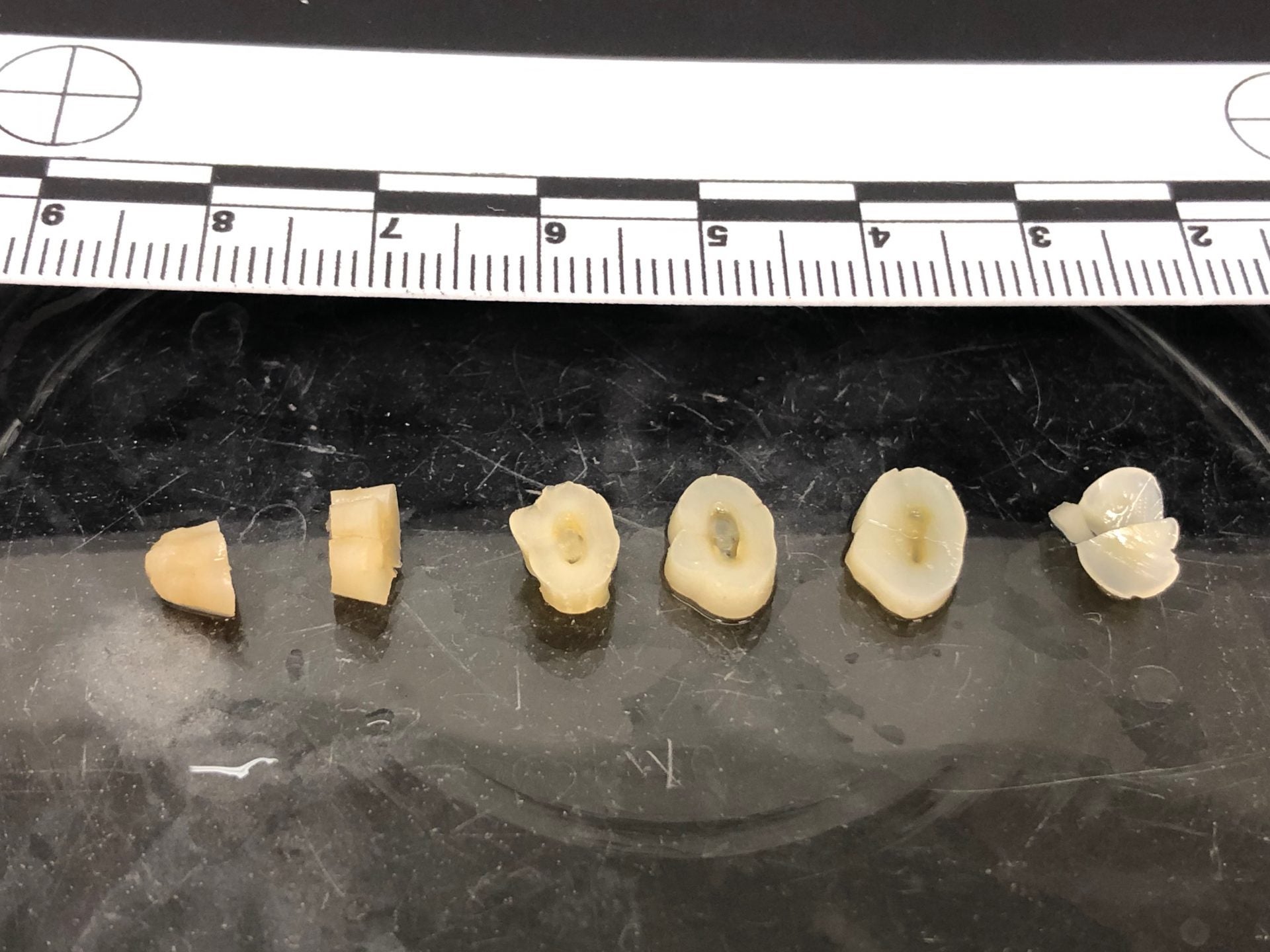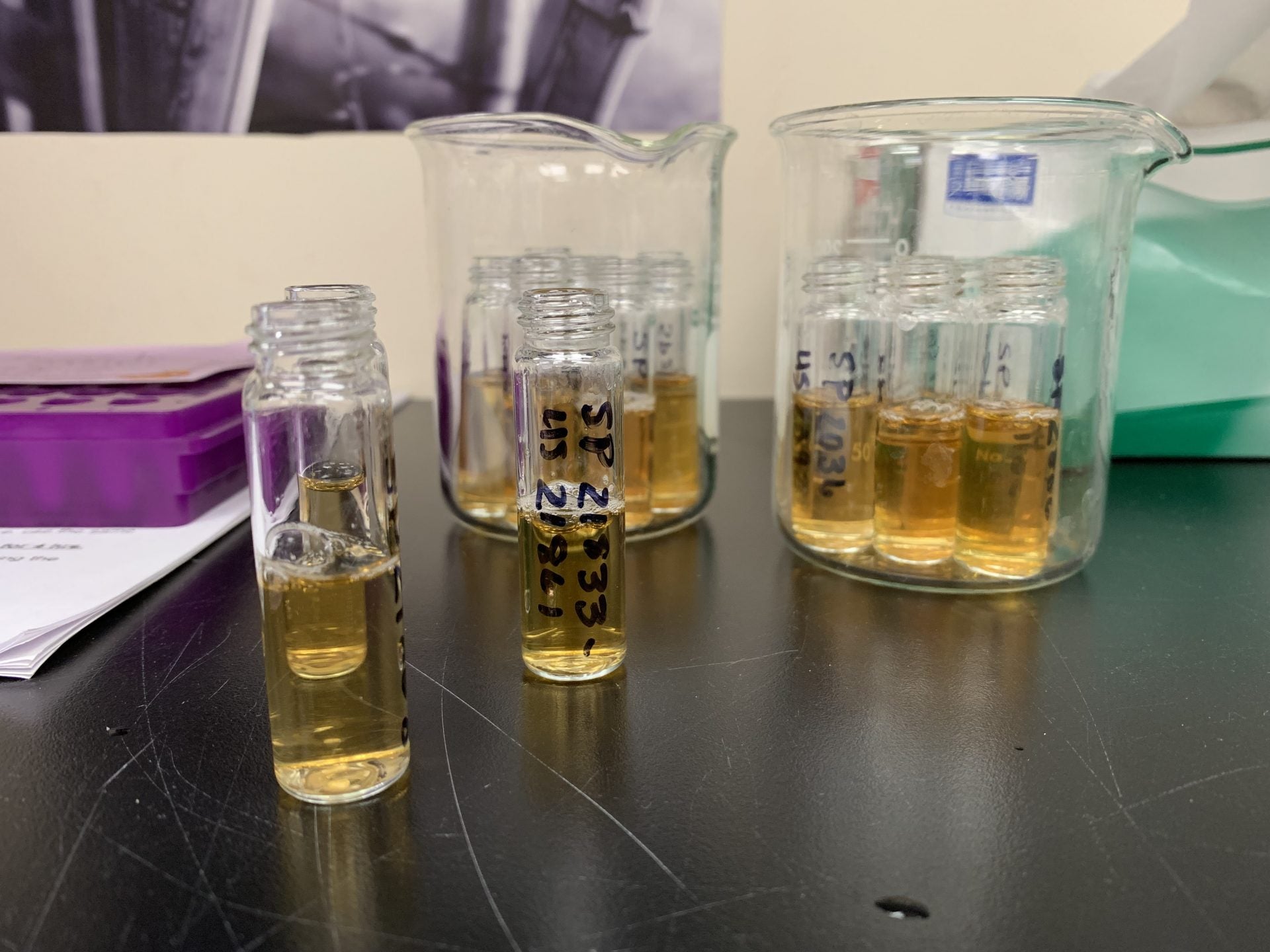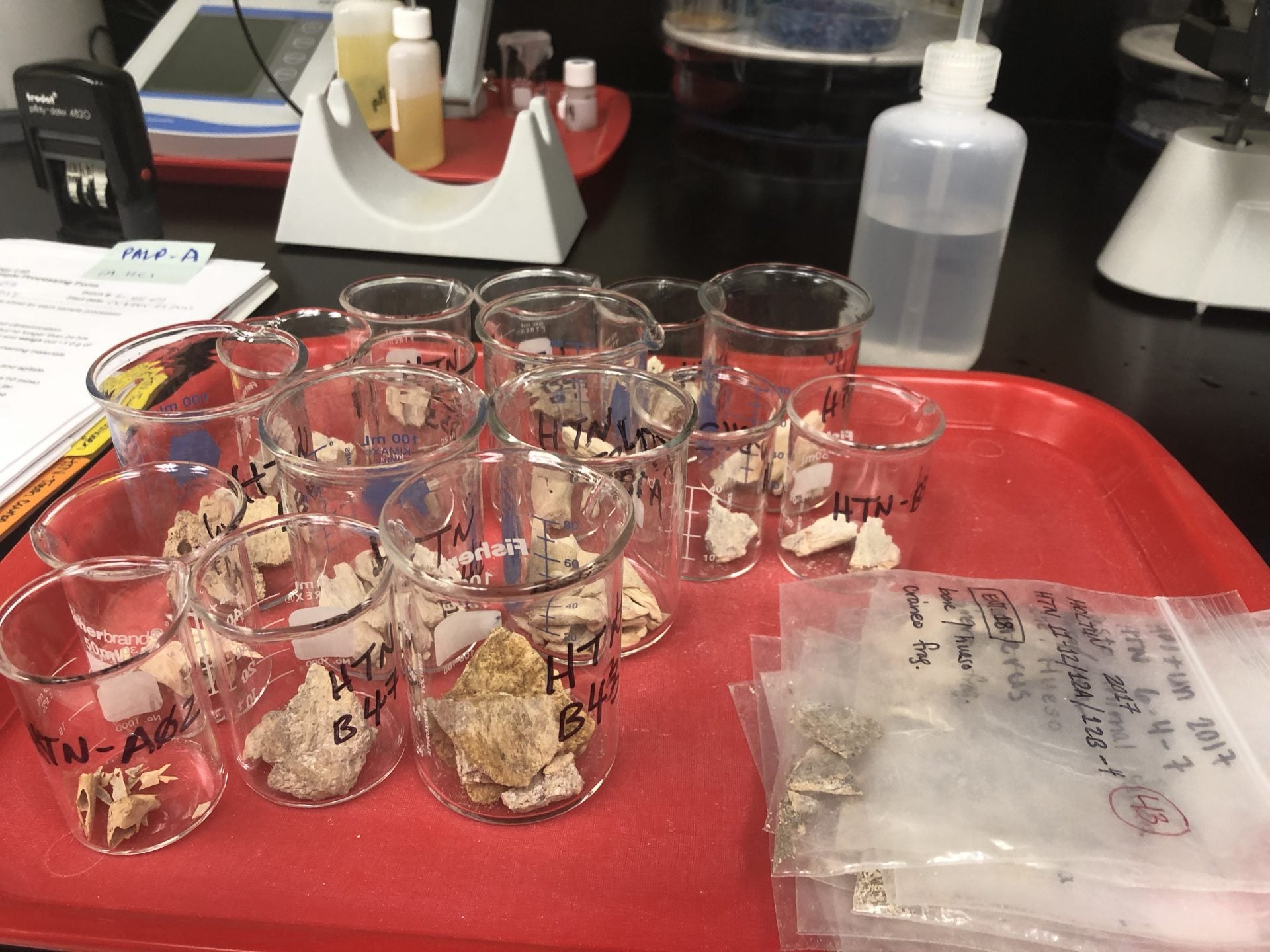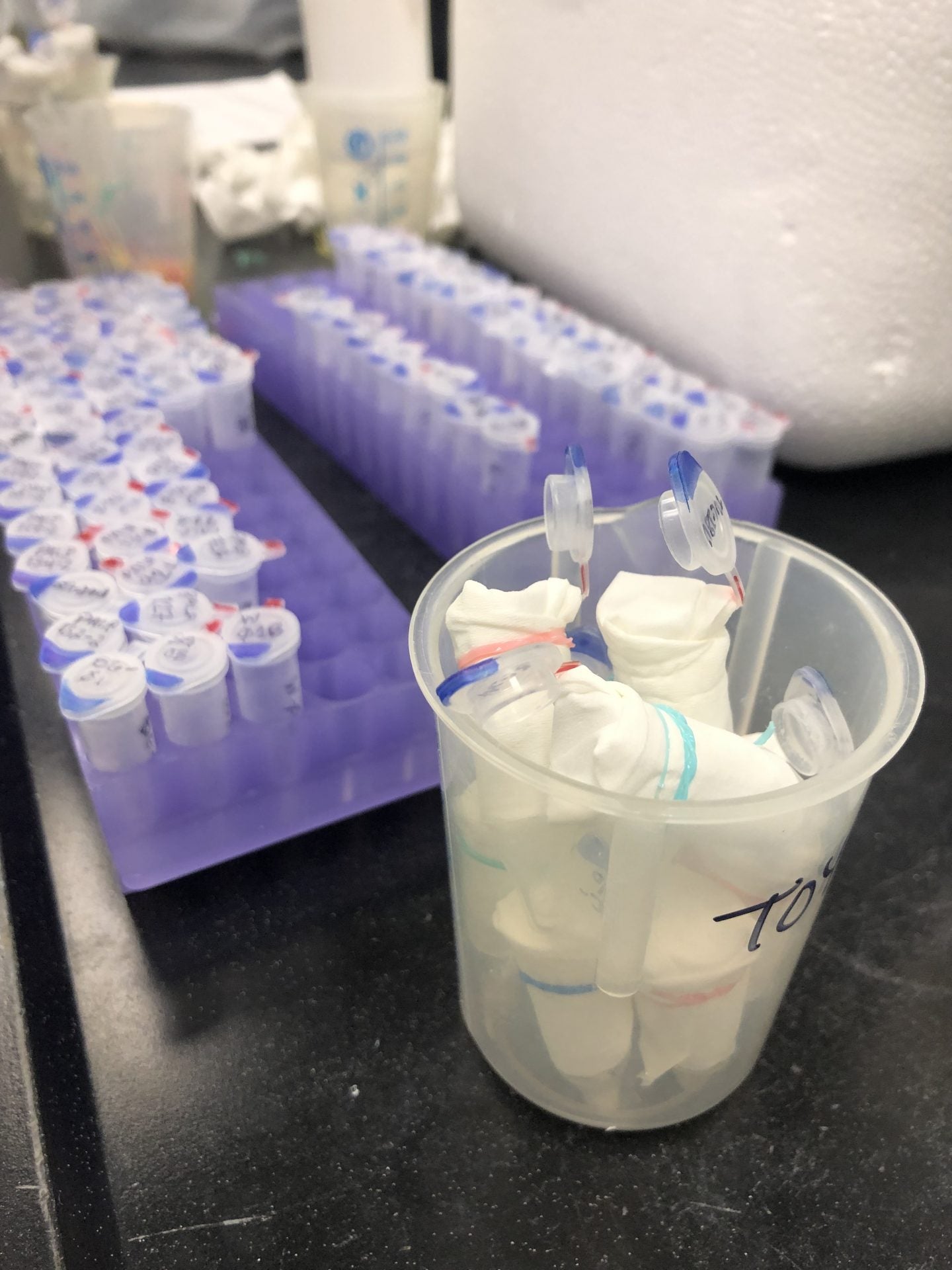Stable isotopes are a part of a science that involves the analysis of atoms of an element that have a different number of neutrons in their nuclei while containing the same number of protons and electrons. The term ‘isotope,’ based on the Greek words isos, meaning ‘same,’ and topos, meaning ‘place’, is based on the fact that isotopes are elements of differing masses that fill the same position on the periodic table. Each element has both a heavy and light isotope variety; light isotopes are usually the more abundant within natural systems. Stable isotopes are reported as delta values (δ) measured as the relative difference between the ratio of heavier and lighter isotopes and the ratio of an international reference standard (Hoefs, 2018).
While the study of variation in stable isotopes have a long history in chemistry, environmental, and geological research, they are a more recent addition to anthropology, specifically archaeology, with an increased in presence in bioarchaeological research. Bioarchaeology is the contextualized analysis of biological remains from archaeological contexts, generally human burials. This synthetic methodology involves the analysis of human skeletons within their historical and social context, applying a biocultural approach to reconstruct aspects of lived experience in the past. The biocultural approach emphasizes a holistic consideration of the complex historical, sociocultural, and environmental context in which humans exist, acknowledging their effect on shaping human biology (Armelagos, 2003; Buikstra, 1977; Zuckerman and Armelagos, 2011). Thus, the naturally occurring and varying stable isotope signatures from human tissues can be an important tool for reconstructing many aspects of human lives.
Since the 1970s, archaeology has seen the increase in the application of stable isotope analyses of biological materials, particularly human remains, to explore bioarchaeological research questions related to dietary patterns and changes, and also residential mobility of individuals and communities. While bioarchaeologists (and forensic anthropologists) most often utilize “traditional isotopes,” hydrogen (δD), carbon (δ13C), nitrogen (δ15N), oxygen (δ18O), and sulfur (δ34S), there are many others that could have novel applications in future research.
Paleodietary Traditions
Stable isotopic analysis of carbon (δ13C) and nitrogen (δ15N) in bioarchaeology produces quantitative data to investigate human and animal paleodietary variation within ancient food systems. Carbon isotopes in food plants vary based on the photosynthetic pathway and discriminates broadly between C3 plants (domesticated foods such as wheat, oats, barley, rice, potatoes, quinoa, legumes, etc.) and C4 plants (domesticated foods such as corn/maize, millet, kiwicha, etc.). Nitrogen isotopes vary across natural systems and primarily reflects dietary protein coming from either terrestrial or marine animals. Nitrogen isotopic variation can be influenced by aridity, elevation, and also the physiological (health) status of individuals (Katzenberg and Waters-Rist, 2019).
Variation in human individual and group access to foods within a society can be reconstructed from this dietary proxy. This relies on the premise, ‘you are what you eat’, where the isotopic composition of preserved tissues reflects consumed foods in a predictable way (Ambrose, 1993). Carbon and nitrogen isotopes are derived from the collagen in the tissues (organic portion). Thus, paleodietary variation can be inferred from preserved human tissues such as bones, teeth, hair, and nails (Ambrose and Norr, 1993). There are some caveats with this approach, which make this an exciting field to explore.
Human diets have evolved from meeting our basic needs from wild resources to those that are reliant on domesticate plants and animals, to highly specialized restrictions or preferences that are socially mediated (Schoeninger, 2014). Environmental resources and cultural practices shape our food behaviors and changes over time reflect major events in human history such as the introduction of maize horticulture and consumption in North America (Larsen et al., 1992).
While there has been a focus on human tissues as direct proxies for past dietary behaviors, baseline models of available food resources are necessary through the creation of food webs, where animal remains and paleobotanical materials are analyzed for their stable isotope compositions (Makarewicz, 2016). This allows an enriched reconstruction of past socio-ecological systems.
Paleomobility Patterns
Humans move around their environment for various reasons. In the past, it is assumed that most people did not move far, and most were buried near their local communities, with the exception of early hunter-gatherers. However, with the development of expanding empires, greater connections among distant locations across the continents, we have the possibility of greater human mobility and migration. Movement could be due to long-distance trade, conquerors, migration, pilgrimages, enslavement of peoples, etc., but also simple human wanderlust travel. Where we examine the stable isotopes of individuals and communities in past cemeteries, we can identify if there is evidence for non-local stable isotope signatures. Sometimes we can trace possible origins for those individuals based on additional bioarchaeological or contextual information.
Oxygen (δ18O) and also hydrogen (δD) isotopes are most often utilized in archaeological studies to determine the geographic origin of human and animal skeletal remains, based on predictable variation in oxygen isotopic signatures from natural waters (H2O) based on geographic and climatological factors (Bowen and Wilkinson, 2002). Hydrological stable isotope research has created broad isoscapes, or baseline maps of δ18O variation around the world.
As oxygen incorporated into human tissues comes from local water consumed, ‘you are what you drink’ is the underlining premise for this research. Oxygen isotopes are derived from carbonates and phosphates in bone and tooth bioapatite (the mineral portion). The isotopic data obtained from the analysis of bones and teeth can be compared to geospatial maps of oxygen isotopic signatures to better understand the residency and movement of individuals in an archaeological sample, including using human remains to identify first generation immigrants (Lightfoot and O’Connell, 2016).
Additionally, radiogenic strontium (Sr) isotopes are used to explore human mobility and migration in the past (Bentley 2006; Szostek et al. 2015). Strontium isotopic signatures move from eroding geologic materials through soils and the food chain into the human skeleton, where strontium substitutes for calcium in the minerals of skeletal tissue. Thus, strontium can be traced to natural geological variation across a landscape. However, strontium isotope ratios (87Sr/86Sr) are based on bio-available strontium in the environment. Both bone and teeth can be used to explore population variation and identify potential outliers as non-local individuals.
~~~~~
Stable isotope analysis is now a consistent tool used by bioarchaeological researchers around the world, exploring questions of human variation from many different time periods. Work with modern human samples and experimental approaches have also furthered our understanding of how isotopes are incorporated into biological tissues and how they vary based on different factors, such as age, biological sex, and health of the individual (Reitsema, 2013). In the realm of forensics, stable isotope analysis has become a useful tool for assisting with identification of recovered remains (Meier Augenstein, 2018).
Some useful introductory references:
Ambrose, Stanley H. 1993. “Isotopic analysis of paleodiet: methodological and interpretive considerations.” In Investigations of ancient human tissue: Chemical analysis in anthropology, edited by Mary K Sandford, 59-130. New York: Gordon and Breach.
Ambrose, Stanley H., and Lynette Norr. 1993. “Experimental evidence for the relationship of the carbon isotope ratios of whole diet and dietary protein to those of bone collagen and carbonate.” In Prehistoric Human bone: Archaeology at the molecular level, edited by Joseph B. Lambert and Gisela Grupe, 1-37. Berlin: Springer-Verlag.
Armelagos, George J. 2003. “Bioarchaeology as anthropology.” Archaeological Papers of the American Anthropological Association 13 (1):27-40.
Bentley, R. Alexander. 2006. “Strontium isotopes from the earth to the archaeological skeleton: A review.” Journal of Archaeological Method and Theory 13 (3):135-187.
Britton, Kate. 2017. “A stable relationship: isotopes and bioarchaeology are in it for the long haul.” Antiquity 91 (358):853-864.
Buikstra, Jane E. 1977. “Biocultural dimensions of archaeological study: A regional perspective.” In Biocultural adaptation in prehistoric America, edited by R. L. Blakely, 67-84. Athens: University of Georgia Press.
Hoefs, Jochen. 2018. Stable isotope geochemistry. 8th ed. New York: Springer Science & Business Media.
Katzenberg, M. Anne, and Andrea L. Waters-Rist. 2019. “Stable isotope analysis: A tool for studying past diet, demography, and life history.” In Biological anthropology of the human skeleton, edited by M. Anne Katzenberg and Anne L. Grauer, 469-504. New York: Wiley-Liss.




